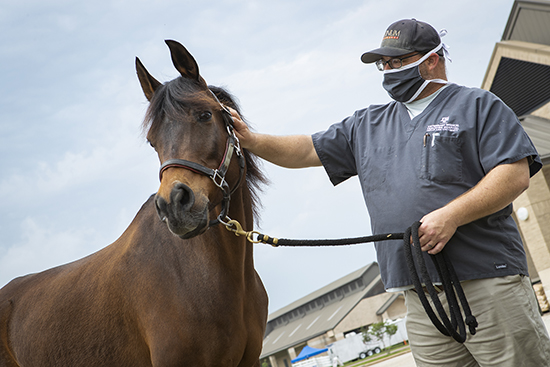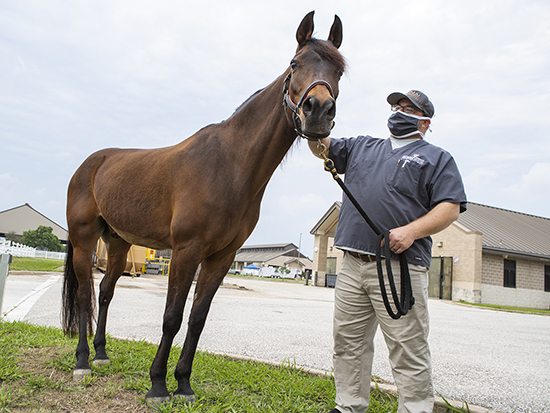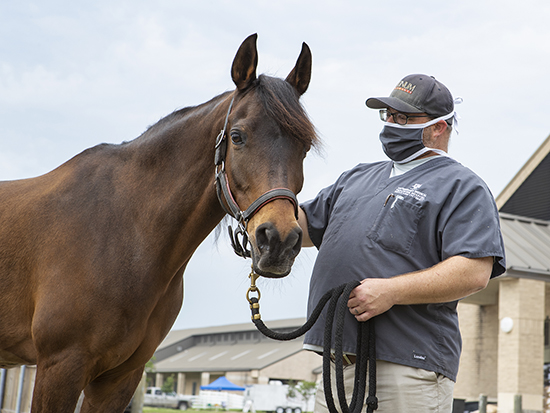Texas A&M LAH Continues To Save Lives During Pandemic
Story by Aubrey Bloom, CVMBS Communications

Some of the processes have changed around the Texas A&M College of Veterinary Medicine & Biomedical Sciences’ (CVM) Large Animal Hospital (LAH) because of the COVID-19 pandemic, but animals and their owners are still getting the great care the hospital is known for.
According to clinical associate professor of veterinary surgery Dr. Joanne Hardy, the recent case of Nadar, a 12-year-old Arabian gelding, highlighted how well the LAH has adjusted.
Nadar’s owner Deborah Hunyady has brought several animals to the LAH in the past, and even had a niece who graduated from the CVM, so when her local veterinarian said he had done all he could do on site and that Nadar needed a hospital, she knew exactly where to take him.
But when she pulled up in early April and saw the outdoor check-in and the trailers from the Texas A&M Veterinary Emergency Team implemented by the CVM to protect employees and clients from COVID-19, she was a little surprised. Another surprise awaited her when she got into the parking lot and was told that she couldn’t accompany Nadar inside like usual because of social distancing guidelines.
“They were very nice about it, and I understood,” she said. “I’m just glad that they were open; if those were the conditions under which they could see Nadar, so be it.”
Nadar came into the LAH with abdominal pain at about 6:30 p.m. and was first seen by Dr. Sarah Thomas, a resident in large animal internal medicine. Thomas, Hardy, and the LAH team decided that Nadar needed surgery as quickly as possible.

“In surgery we found what’s called a small intestinal volvulus, which essentially means the small intestine is twisted on itself 360 degrees,” Hardy said. “Not only can the food not get through because it’s twisted, but it’s also cutting off the blood supply to the intestine, so if you leave it like that, the intestine is going to die.”
In cases like these, veterinarians often find extensive damage and a portion of the intestine usually has to be removed, which can lead to a difficult recovery, but not only were the LAH surgeons able to untwist the intestine, they were able to begin the surgery quick enough that the affected part of the intestine did not need to be removed.
Still, Hardy expected Nadar to have a difficult recovery, which is typical in this kind of surgery.
“When we had a conversation with the owner, I was concerned that the horse was going to be pretty sick afterward,” she said. “Even though we didn’t think the intestine needed to be removed, it was still really bruised and had a lot of change in color, so I thought the horse would be a lot sicker than he was.”
The main concern after this kind of surgery is digestive motility, or how quickly the movement through the digestive system returns to normal, but Nadar didn’t have any problems with that and was back with his owner in only a week.
Hunyady said that even though she couldn’t accompany him inside like normal, she knew Nadar was in good hands and appreciated the constant updates from the LAH team.
“Dr. Thomas talked to me twice a day,” she said. “She got to know Nadar really well, to the point that she could tell from his personality when he wasn’t feeling well and when he was. That she got to know Nadar so well gave me comfort.”

Nadar is already back home in Conroe, Texas, and Hunyady said it was another great experience at the LAH.
“Every day after the surgery he was doing a little better and better,” she said. “I was thrilled. “When this happened, even my local veterinarian said you were smart to take him to A&M. There was no doubt in my mind that was the right choice.”
What she didn’t know, though, was how much things were changing behind the scenes. Between changing operations to limit exposure inside the hospital and the absence of the fourth-year veterinary students on site, the hospital is working with fewer staff than usual. But the staff aren’t letting that impact their care.
Along with Thomas and Hardy, the team included large animal surgery resident Dr. Alyssa Doering, veterinary intern Dr. Chelsea Dunnehoo, senior anesthesiologist Dr. Keila Ida, anesthesia technician Derek Osborne, surgery technician Sarah Adams, and many more from the intensive care unit team.
“The whole team is so important because when we’re dealing with a 1,000-pound animal that has to undergo general anesthesia for surgery, it isn’t something that anyone can do by themselves,” Hardy said. “Everything went really smooth and it was a really good reflection of an amazing team that I get to work with every day.”
###
For more information about the Texas A&M College of Veterinary Medicine & Biomedical Sciences, please visit our website at vetmed.tamu.edu or join us on Facebook, Instagram, and Twitter.
Contact Information: Jennifer Gauntt, Director of CVM Communications, Texas A&M College of Veterinary Medicine & Biomedical Sciences; jgauntt@cvm.tamu.edu; 979-862-4216


